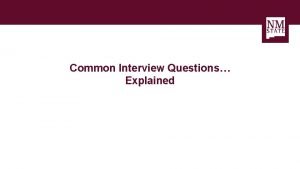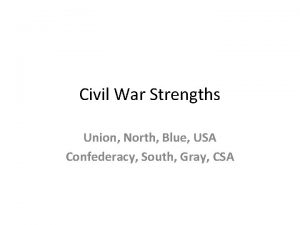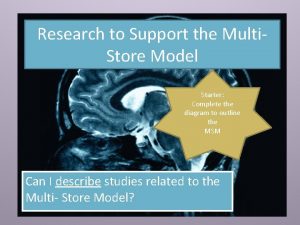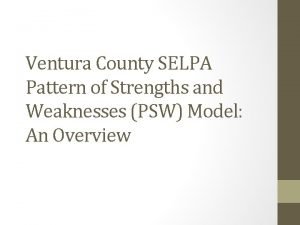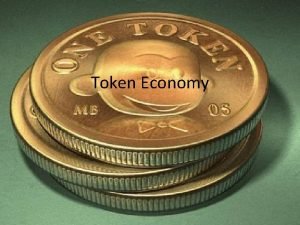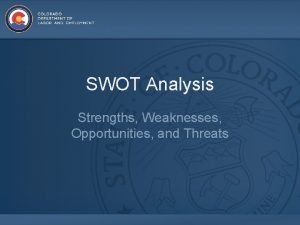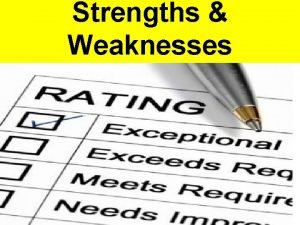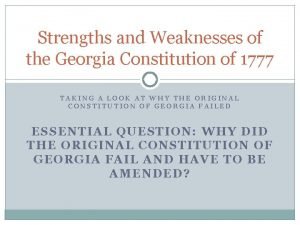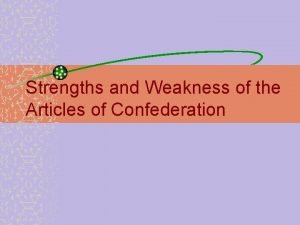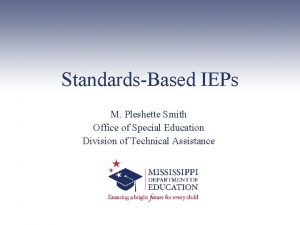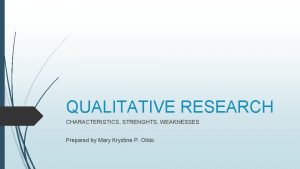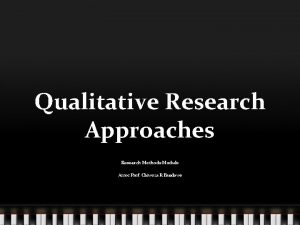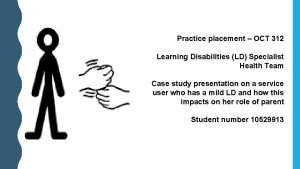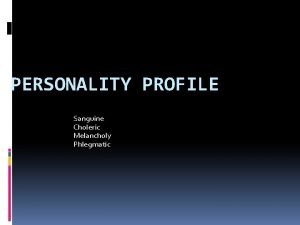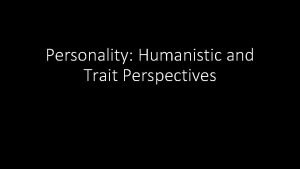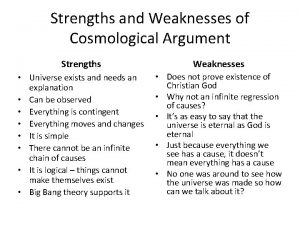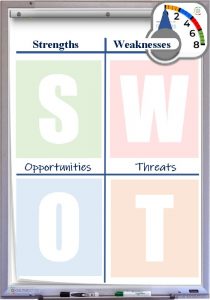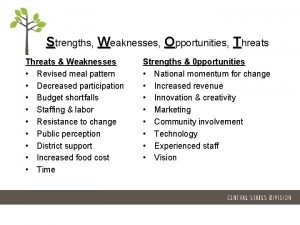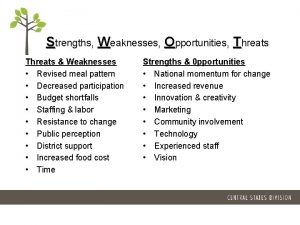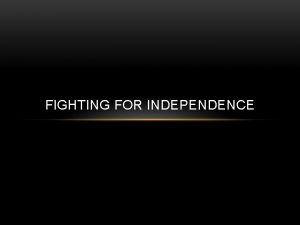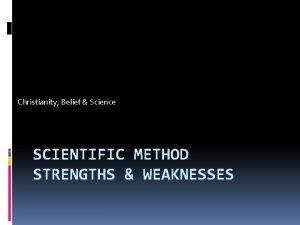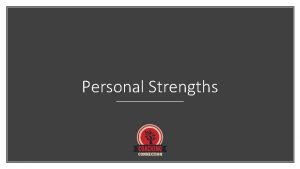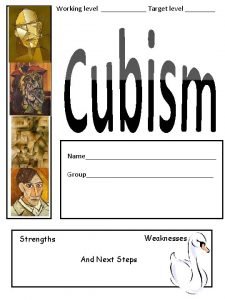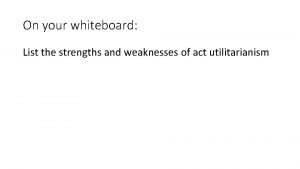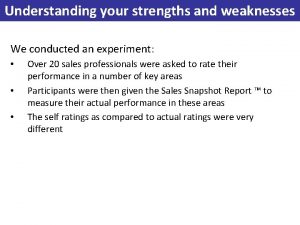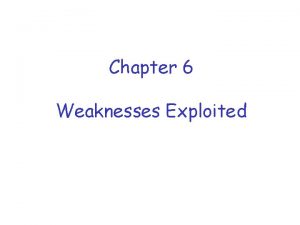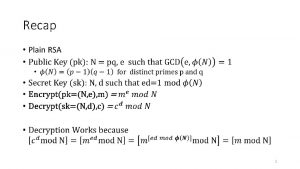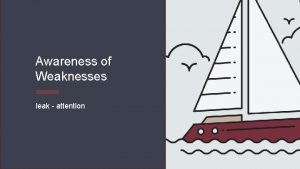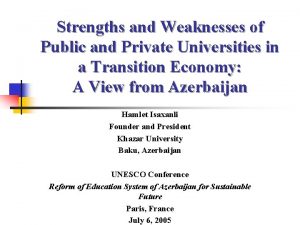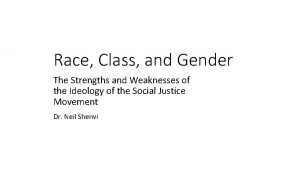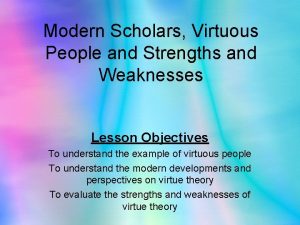Working to your Strengths and overcoming weaknesses An





























- Slides: 29

Working to your Strengths (and overcoming weaknesses) An introduction to Personality Types MBTI – Myers Briggs David Craigie 30 th September 2014

Overview Understanding Personality Advantages (and dangers) of Type Exploring Personality with MBTI Practical Applications and Tips

Mahatma Gandhi “I want freedom for the full expression of my personality. ”

What is Personality? “the combination of characteristics or qualities that form an individual's distinctive character” Oxford Dictionary “the complex of characteristics that distinguishes an individual”; “the totality of an individual's behavioral and emotional characteristics” Merriam-Webster

Early personality measures The Greek physician Hippocrates (460 – 370 BC) proposed one of the earliest personality type systems, based on bodily fluids: Sanguines (pleasure seeking, sociable) Cholerics (ambitious, leader-like) Melancholics (analytical, quiet) Phlegmatics (relaxed and peaceful)

Pros and Cons of Type Understanding personality as a type has advantages and disadvantages Pros: helps us gain a much broader understanding of groups and meet the needs of others in practical ways Cons: can lead to temptations of overgeneralising or discrimination

The MBTI One of the most popular measures of Type across the world is the Myers Briggs Type Indicator (MBTI) Developed and statistically researched and refined over the last 60 years, based on Type theory by Carl Jung and developed by Isabel Myers and her mother Katharine Briggs.

Serious uses of MBTI Stress Management Career Decisions Conflict Management Decision Making Team Building Change Management Time Management etc

Less serious uses of MBTI The popularity of MBTI has led to some slightly less statistically valid uses. . .




Exploring the MBTI 4 personality “dimensions” Each dimension has one of two preferences This gives one of 16 four letter types What does it mean to have a personality preference?

Preferences Each day, we will use both preferences on each dimension Our natural preference will lead us to typically choose one over the other It is possible, through training and awareness, to consciously operate in our less-preferred mode

How we are energised Extraversion (E) is not about being gregarious or fun-loving, but rather about being energised by and drawn to interaction with the outer world Introversion (I) is not about being shy or reserved, but rather about being energised by the inner world and reflection

How we take in information Sensing (S) is not about being sensitive or intuitive, but rather is about being focused on information that is real and tangible, often detail focused and practical Intuition (N) is not about gut feeling, but rather a preference for the bigger picture, patterns and concepts, often future focused

How we make decisions Thinking (T) is a process that values logic, more objective analysis, and can appear “tough minded”. Fairness is more likely to be about equality. Feeling (F) is a process that values empathic, more subjective and valuesbased reasoning, and can appear “tender hearted”. Fairness is about treating people as individuals.

How we relate to the outer world Judging (J) is not about being judgemental, but rather seeking to plan, organise and regulate or control life, feeling energised once decisions are made Perceiving (P) is not about being perceptive, but is a preference for flexibility, spontaneity and experiencing life in a very adaptable and open-ended way

The 4 dimensions Extraversion (E) --------- Sensing (S) --------- Thinking (T) --------- Judging (J) Introversion (I) --------- Intuition (N) --------- Feeling (F) --------- Perceiving (P)

Finding your best fit Remember that we each use all the preferences at some point each day However, we have a natural preference (similar to having a dominant hand) for one of each pairing E or I S or N T or F J or P

How can I identify my Type? Read the descriptors and choose which is most naturally or comfortably you Ask people who know you well Complete a formal psychometric questionnaire Compare the findings, read descriptions of your most likely Type and choose your closest match

www. opp. eu. com

Understanding others Extraverts can appear fickle or overbearing, and Introverts can appear closed and reserved Sensing types appreciate practical facts, whereas Intuitives appreciate the bigger picture

Understanding others Thinkers can appear thick skinned and harsh, and Feelers can appear illogical and over-sensitive Judgers appreciate knowing in advance and having a plan, whereas Perceivers can feel constrained by excessive policy and procedure

Well-being and Blind Spots Knowing how you are energised can help with your time management, work life balance and stress Try to use all 4 “function” preferences S – N – T – F when making decisions

Points to Ponder What is my most likely Personality Type? How would these preferences express themselves in my work and personal lives? What differences might I see in colleagues, friends or family and how can I help support their own preferences?

What next? Retreat to the safety of your office. . . Start to explore your personality Type to learn more about yourself and your colleagues Sign up to our MBTI Personality Masterclass on October 21 st!

What's more to know? How personality develops over time How our personalities respond to stress How we can manage interpersonal relationships more effectively Using personality in our career development

Any Questions? david@craigiepartnership. co. uk www. businessmattersedinburgh. com
 Leadership strengths and weaknesses list
Leadership strengths and weaknesses list Swot johnson and johnson
Swot johnson and johnson Marks and spencer competitors analysis
Marks and spencer competitors analysis British strengths and weaknesses
British strengths and weaknesses Strengths and weaknesses of the union and confederacy
Strengths and weaknesses of the union and confederacy North and south strengths and weaknesses chart
North and south strengths and weaknesses chart Glanzer and cunitz strengths and weaknesses
Glanzer and cunitz strengths and weaknesses Mbti strengths and weaknesses
Mbti strengths and weaknesses Tabas curriculum model
Tabas curriculum model Patterns of strengths and weaknesses worksheet
Patterns of strengths and weaknesses worksheet Token economy strengths and weaknesses
Token economy strengths and weaknesses Articles of confederation characteristics
Articles of confederation characteristics Plaafp strengths and weaknesses examples
Plaafp strengths and weaknesses examples Pnp swot analysis example
Pnp swot analysis example 3 strengths and weaknesses
3 strengths and weaknesses Marketing manager weaknesses
Marketing manager weaknesses Strengths and weaknesses of a business examples
Strengths and weaknesses of a business examples Medusa strengths and weaknesses
Medusa strengths and weaknesses Strengths and weaknesses of the legislative branch
Strengths and weaknesses of the legislative branch Weakness and strengths of the articles of confederation
Weakness and strengths of the articles of confederation Plaafp strengths and weaknesses examples
Plaafp strengths and weaknesses examples Schema evaluation
Schema evaluation Strength and weaknesses of qualitative research
Strength and weaknesses of qualitative research Ethnography strengths and weaknesses
Ethnography strengths and weaknesses Strengths and weaknesses of psychodynamic theory
Strengths and weaknesses of psychodynamic theory Mohost manual
Mohost manual Pizza hut swot analysis
Pizza hut swot analysis What is phenomenology
What is phenomenology Sanguine, choleric, melancholic and phlegmatic
Sanguine, choleric, melancholic and phlegmatic Humanistic theory strengths and weaknesses
Humanistic theory strengths and weaknesses
